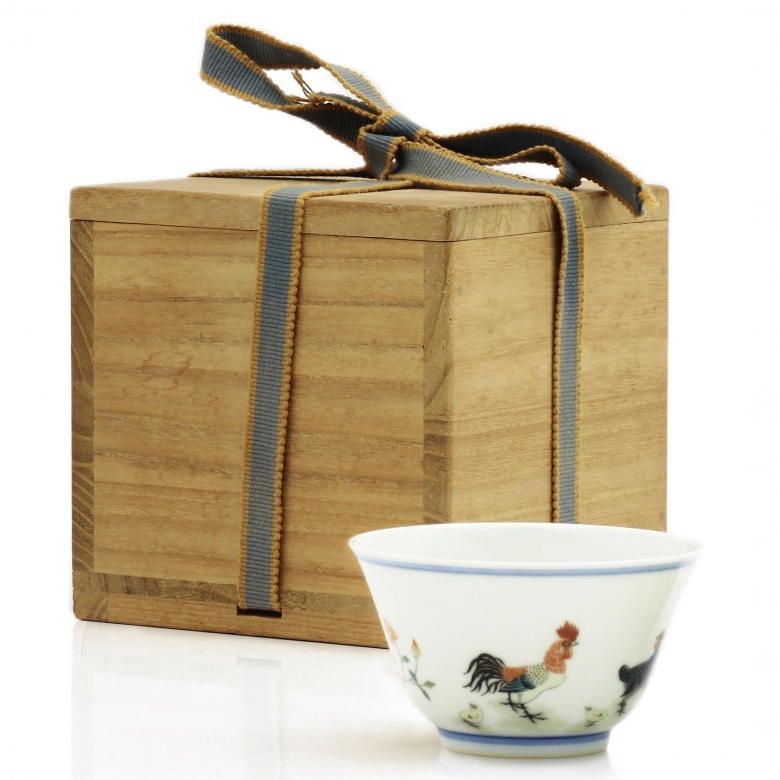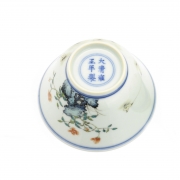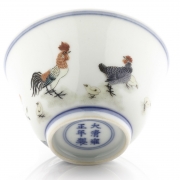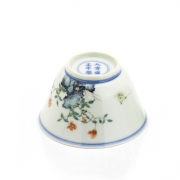LIVE AUCTION JUNE 24TH - 1st SESSION "ASIAN FINE ART"
Fine and rare Doucai "Chicken Cup", Yongzheng (1723-1735).
Press 'Program an autobid'in order to confirm
SIX-CHARACTER MARK (大淸雍正年製 ) IN UNDERGLAZE BLUE INSIDE A DOUBLE CIRCLE AND OF THE YONGZHENG PERIOD (1723-1735).
Modelled after the Ming Chenghua prototype, this cup has been potted forming a U-shape with deep sides. It rises over a circular base where a six-character reign marks (大淸雍正年製 ) is inscribed within a double circle, both details in underglaze blue.
Delicately painted in a Doucai style with characteristic soft enamels, this ‘chicken cup’ depicts a hen, a rooster and five chicks on a glassy bank with flowers. The reverse is covered with underglaze blue rocks which have been accentuated with red rose blooms and lush leaves. The lip and the foot present a double-line border, also in underglaze blue.
Diameter: 8.2 cm
Japanese wood box.
References:
Sotheby's, Hong Kong, April 5, 2017. Lot 3106 - Sold for: 12,100,000 HKD (1,557,149 USD)
Christie's, Hong Kong, June 3, 2015. Lot 3144 - Sold for: 9,040,000 HKD (1,164,370 USD)
Provenance:
Acquired in 1923 from Kumasaku Tomita, Kyoto.
The current owner is an important Dutch collector who bought the present piece in 2019 from a large and reputable collector in Kyoto, Japan, who for privacy reasons has asked not to be named. He very kindly provided us with the document of the purchase, made in Kyoto, which contains an application for a special export license for antique pieces over 100 years old. This clearly states that it was purchased by the Kyoto collector in 1923 from Kumasaku Tomita and details as "IMPERIAL CHICKEN CUPS YONGZHENG, 1923 Kumasaku Tomita". Indicating that it belonged to his collection between 1919 to 1923. It should be noted that in Japan it is strictly punishable by law to forge, mislead or lie about the documentation or sale of antiques and art.
Kumasaku Tomita (1872-1953) was the son of a rice wine wholesaler in Hyogo Prefecture. In 1897, Kumasaku Tomita was hired by the famous Osaka art dealer Yamanaka & Co for the London branch of the Chamber of Commerce. He soon became the manager of the company and ran the branch. During his time at the company, he acted as an organizer of important exhibitions such as the British Red Cross exhibition about Japanese art held in 1915. He was also a great collector of oriental pottery. In 1922 he returned to Japan and settled in Kyoto.
Notes:
The term ‘chicken cup’, which denotes a tiny porcelain wine cup painted with cocks, hens and chicks, has for centuries evoked one of the most desirable possessions for connoisseurs of Chinese works of art – imperial and otherwise. Emperor Chenghua related that this scene reflects how the current generation cares about the next. He even considered that the hen taking care of the chicks was a way of ruling the country.
A ‘chicken cup’ is not only celebrated as one of the finest and rarest specimens of Chinese ceramics – its materials, potting, painting and firing being of the highest quality. Praised and desired by Ming (1368-1644) and Qing (1644-1911) emperors, ‘chicken cups’ have acquired a legendary aura that goes well beyond their immediate art-historical importance and has placed them as the crowning glory of any collection of Chinese porcelain or any other discerning literati collectors.
In the case of the Kangxi ‘chicken cups’, the tails are painted in black enamel. However, this enamel was neither glossy nor stable. In order to prevent it from being rubbed off, the paint had to be covered in a clear pale green or purple enamel. This technique also provided depth and gloss. It was not until the Yongzheng reign that a true glossy black enamel was developed, allowing the porcelain decorators to apply the colour in calligraphic styles – both for calligraphy itself, and in the painting of trees, rocks and the tails of roosters. In an apparent celebration of this new enamel, and the freedom it gave to the ceramic artists, the tails of the roosters on the current ‘chicken cup’ have been redesigned to emphasise the richness, fluency and movement of the birds’ natural feathers.
* If you are a not a premium user at Darley Auctions you must pre-register to bid on the current lot. It is compulsory send the application at least two working days before the sale. To bid on this lot via Telephone or Online at any platform you must complete the registration process at least 24 ours prior to the sale. Darley Auctions reserve the rights to don't accept any application completed after the present deadline. For more detailed informationsk email info@subastasdarley.com.














































